CPS1 and CPS2: 'county' planning matters return - guidance notes
Updated 24 January 2020
Applies to England
Useful information
The purpose of these forms
The CPS1 and CPS2 forms collect information about the range of county matter applications that county matter planning authorities handle when exercising their development management functions. Only applications relating to county matters should be recorded on the CPS1/2 form (with the exception of Questions 5 and 7). Any authorities with responsibility for district matters should record all district matter applications on the PS1/2 form.
The figures collected are summarised and published as National Statistics in the Planning application statistics quarterly statistical release and in a range of associated live tables and interactive dashboards. The statistics are used by central government to monitor planning policies and performance, and by a wide range of other users including local authorities, academics and the general public.
The forms are included on the Single Data List and so are required to be completed by every relevant local planning authority.
The CPS1 form is concerned with county matter applications and collects summary information about the number of planning and related applications on hand at the beginning of the quarter, received, withdrawn, called in or turned away during the quarter; the number of decisions and delegated decisions; and information on specific types of applications such as applications accompanied by Environmental Statements, Regulation 3 and 4 consents, decisions on applications for prior approval, determinations applications and enforcement action.
The CPS2 form collects more details about the decisions made during the quarter, broken down by:
a. Development type
b. Whether permission / consent was granted or refused; and
c. The time taken from application to decision
Who should complete this form?
CPS1 and CPS2 returns are required from each local planning authority in England with responsibility for ‘county matters’ planning applications (see below for definition). These are county councils, National Park authorities, metropolitan districts, unitary authorities, London borough councils and some Urban Development Corporations.
Where relevant, National Park Authorities, and Urban Development Corporations should complete a single return for county matters which should relate to their entire area (and a separate return for district matters).
Contacts for help
If you have any problems providing the data required in the return please contact planning.data.collection@levellingup.gov.uk, and a member of the team will get back to you.
If you experience any technical issues with the DELTA system, please contact the DELTA Service Desk (Portal is the preferred option).
To log in to DELTA visit https://delta.communities.gov.uk/login and use the username and password provided to you previously. If you have not received login details, please contact the DELTA Service Desk (Portal is the preferred option).
Revisions
Despite local authorities’ best efforts, it is unlikely that all data submitted is completely accurate, whether through the receipt of subsequent information not available at the submission deadline, errors in calculation, or another reason. As such, our Revisions Policy allows for local authorities to correct errors found, in order to maximise the quality of our published data. Many revisions see only minor changes made to data, with little to no impact on published national statistics. These changes will be published at the next scheduled release, with no specific announcement, and the previously released data is not revised.
These revisions can be made for the previous seven quarters, in line with the time period covered by the department’s designation tables (Live Tables P151 to P155). They can be made through DELTA. If you realise that you need to make a revision, please get in touch with our team (planning.data.collection@levellingup.gov.uk) and we will arrange access to the relevant quarter so you can make the required corrections. You will receive an email, with a link to the data you have previously submitted and requested to revise. Following this link will allow you to amend the data for that quarter and re-submit.
Some revisions are considered major revisions. These might date further back than the previous seven quarters and include the late submission of a local authority with a notable impact at the national level, substantial errors in the statistical process, or other major methodological issues, whether by local authorities or central government. Major revisions may require a non-scheduled revision of the statistical release to be published, along with a correction notice explaining the error. We aim for transparency in such cases, in order to maximise the perception of quality in all official statistical releases. If you think that you need to make a major revision, please get in touch with our team at the above email address.
The policy on revisions has been developed in accordance with the UK Statistics Authority Code of Practice for Statistics and the department’s revisions policy.
Completing the returns
Completed forms should be submitted on DELTA by 4 August 2023.
Please complete all boxes on the CPS1 and 2 forms as set out in the notes below.
When signing off the return, boxes should not be left blank. If there is no activity to record for the period, you should enter a ‘0’ (zero) in the relevant box.
Please ensure that you complete the box at the end to say that the return is final.
As the user completes the return, validation rules (where appropriate) will be displayed.
To log in to DELTA visit https://delta.communities.gov.uk/login and use the username and password provided to you previously. If you have not received login details, please contact the DELTA Service Desk (Portal is the preferred option).
Please note: this process currently functions better when using Google Chrome as your web browser.
Email reminders will be sent periodically to alert data providers that the collection instance to submit data is live.
Once you have signed into DELTA you will arrive at the Welcome Page.
To navigate to the current collection instance for the CPS1/2 form manually, please follow the steps set out below:
1. Click on ‘Submissions’ to submit data.
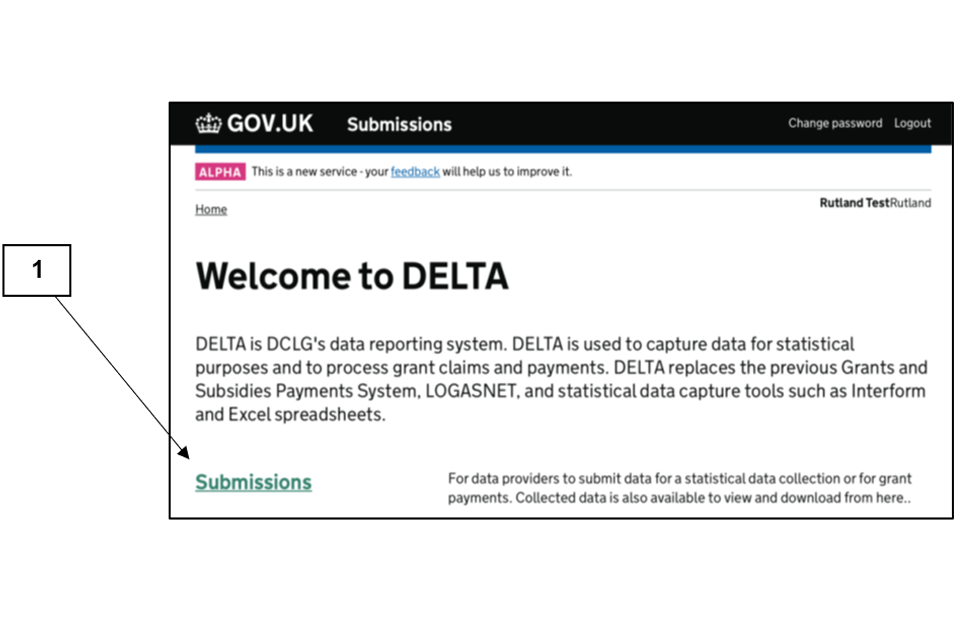
submissions screenshot
2. Click on ‘Collection Requests’.
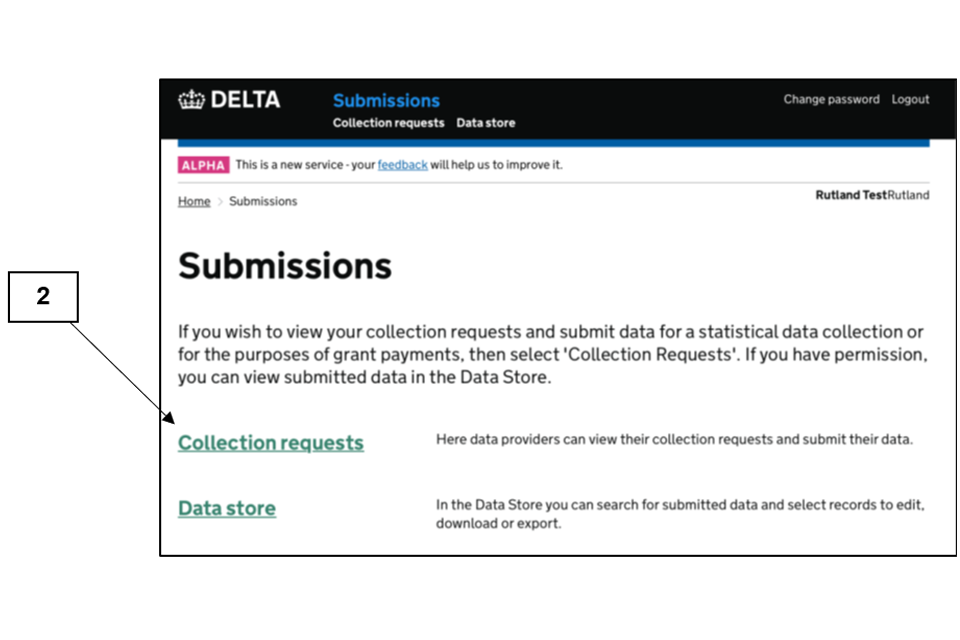
collection requests screenshot
3. Navigate to the correct instance of the form you are submitting data for – multiple instances of the form exist, covering each quarter.
You will have received a notification with the exact name of the form awaiting completion and can use this as your reference. You can also sort by the most recently added form or search using the search field. If you are unsure, please contact planning.data.collection@levellingup.gov.uk.
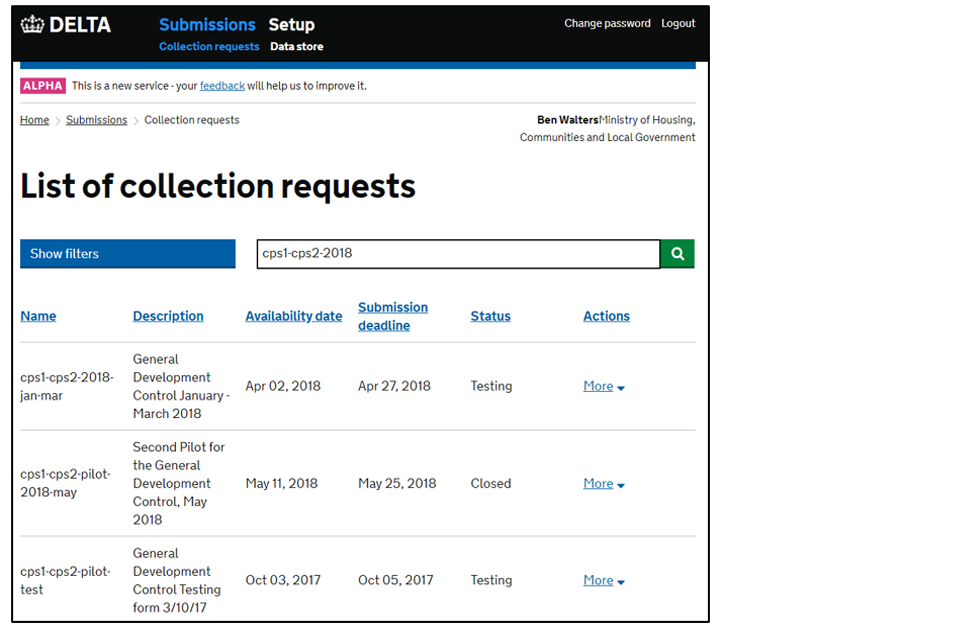
3 list of collection requests screenshot
4a. Once you have navigated to the correct form, under Actions select the drop-down menu ‘More’ for the instance on which you wish to submit data.
4b. Select ‘Provide Data’.
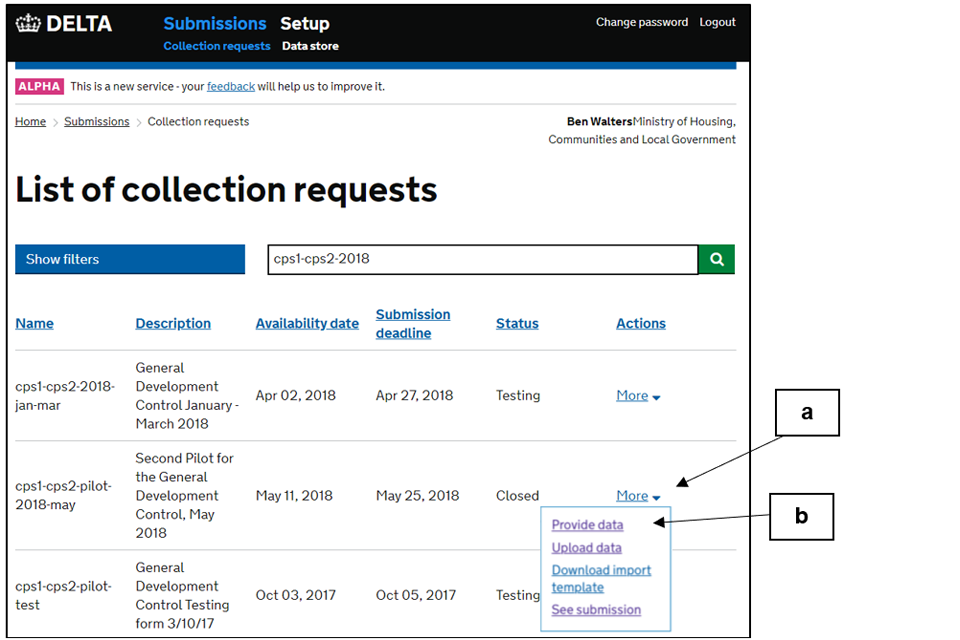
4 list of collection requests screenshot
Note: In the example above, the selected form would refer to the CPS1/CPS2 pilot form of May 2018, with collection between 11 May and 25 May.
Warning
Please note that after logging in and navigating to the correct form to submit your data, the system will automatically log you out after 15 minutes of inactivity.
We recommend that you regularly save your submission to ensure that no data is lost.
Instructions on how to save, print and submit for are included below for each form.
CPS1
CPS1 Questions 1 and 2
The following applications should be included under Questions 1 and 2:
(a) Valid applications for planning permission for development under Articles 5,6 and 7 of the Town and Country Planning (Development Management Procedure) (England) Order 2015 (as amended) namely:
(i) Applications for outline planning permission
(ii) Applications for approval of reserved matters
(iii) Applications for full planning permission
This should include any application for time limited permission and any application that is accompanied by an environmental statement.
(b) Valid applications under section 73 of the Town and Country Planning Act 1990 to vary or remove conditions (including applications for minor material amendments) except applications for prior approval made under section 73, which are to be reported at question 6.
(c) Valid applications under regulations 3 and 4 of the Town and Country Planning General Regulations 1992 (SI 1992/1492) (as amended) where these relate to ‘county matters’ only. (County councils should record regulation 3 developments that relate to non-county matters under Question 5 only).
(d) Developments which would normally have been permitted under the Town and Country Planning (General Permitted Development) (England) Order 2015 (SI 2015/596) but have come before the local planning authority for determination because they require an Environmental Impact Assessment.
(e) Consolidating permissions for the winning or working of minerals.
The following should be excluded from Questions 1 and 2:
(a) Non-material amendments under section 96A of the Town and Country Planning Act 1990.
(b) Registrations, applications and schemes submitted for old mining permissions, and applications and schemes submitted for old mineral planning permissions.
(c) Any response to consultation by the county planning authority to a district planning authority under paragraph 7 of Schedule 1 to the Town and Country Planning Act 1990.
(d) Applications for the discharge of conditions under Article 27 of the Town and Country Planning (Development Management Procedure) (England) Order 2015.
(e) Prior approval of development permitted under the Town and Country Planning (General Permitted Development) (England) Order 2015.
(f) Certificates of lawful development. This includes:
(i) Existing uses and developments (under section 191 of the Town and Country Planning Act 1990), and
(ii) Proposed uses and developments (under section 192 of the Town and Country Planning Act 1990). These are recorded only in Question 7b
(g) Decisions in response to notifications under DOE Circular 14/90 (Overhead Electric Lines).
(h) Certificates of appropriate alternative development. Certificates of Appropriate Alternative Development are an aid to valuation when land is taken by compulsory purchase. They state what planning permissions might have been granted if the scheme underlying the compulsory purchase had been cancelled on the day the notices for the compulsory purchase were issued. These are recorded only in Question 7c.
(i) Screening opinions, screening decisions, scoping opinions and scoping directions issued under The Town and Country Planning (Environmental Impact Assessment) Regulations 2011 (SI 2011/1824). These do not form part of any subsequent planning application and should not be recorded as separate applications.
(j) Applications for Hazardous Substances Consents under the Planning (Hazardous Substances) Regulations 2015.
(k) Applications for prior approval made under section 73 of the Town and Country Planning Act 1990 to vary or remove conditions, which are to be reported at question 6.
Question 1: Applications

q1
This question asks you to record how many valid applications were:
- Question 1a: on hand at the beginning of the quarter
- Question 1b: received during the quarter
- Question 1c: withdrawn, called in or turned away during the quarter
On Question 1c, the following should be included:
(a) Withdrawn applications (an application withdrawn in the current quarter may, of course, be one that was entered in the Register in an earlier quarter). Applications that were initially validated but later found to be incomplete should be included both in the number of applications received and, in the number, withdrawn.
(b) Non-determined applications subject to appeal under section 78(2) of the Town and Country Planning Act 1990.
(c) Applications which have not been formally withdrawn but in the opinion of the local authority will never be determined.
(d) Applications called in for determination by the Secretary of State under section 77 of the Town and Country Planning Act 1990 or by the Mayor of London under section 2A of that Act.
(e) Applications which the local planning authority has declined to determine (in exercise of the power available to it under sections 70A, 70B or 70C of the Town and Country Planning Act 1990).
(f) Applications finally disposed of as defined in Article 40(13) of the Town and Country Planning (Development Management Procedure) (England) Order 2015 (as amended).
Question 2: Decisions during the quarter
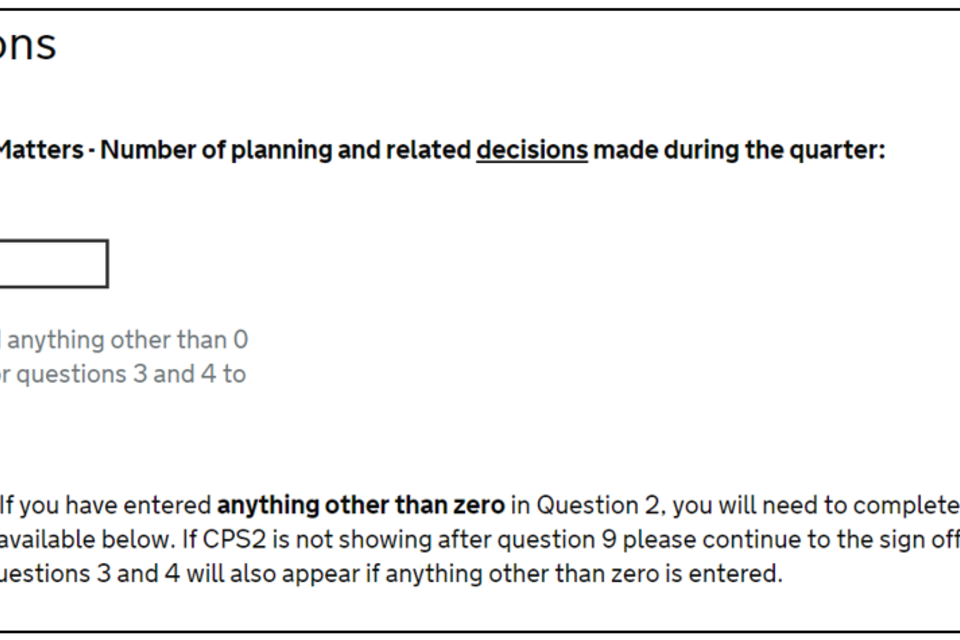
q2
This asks for the total number of ‘county matters’ applications which were determined during the relevant quarter and determinations on applications made under Regulations 3 and 4 of the Town and Country Planning General Regulations 1992 (where these relate to ‘county matters’). For the purposes of this return an application is not determined until the notice of determination is despatched.
As the notes within the form (pictured above) suggest, entering a non-zero answer for this question will cause Questions 3 and 4 to appear, as well as the CPS2 form. Questions 3 and 4 will appear directly below Question 2, while CPS2 will appear at the end of the form (prior to the sign off section). If neither appear, then please wait a moment while the form fully loads.
The table below summarises the decisions that to be included within Question 2, and how they relate to other questions on the CPS1 form and to the CPS2 form.
| Question | To be included within CPS1 Q2? | To be included within the CPS2 form? |
|---|---|---|
| CPS1 Q3 (Delegated decisions) | Yes | Yes |
| CPS1 Q4 (Decisions involving Environmental statements, Planning Performance Agreements or extensions of time) Yes | Yes | |
| CPS1 Q5 (Regulation 3 and 4 decisions where these relate to county matters only) | See note below | See note below |
| CPS1 Q6 (Prior approval for permitted development rights) | No | No |
| CPS1 Q7 (Decisions on notifications, certificates of lawful development and certificates of appropriate alternative development) | No | No |
| CPS1 Q8 (Determinations under ROMPs) | No | No |
| CPS1 Q9 (Enforcement action) | No | No |
Question 5 records regulation 3 and 4 decisions. For county councils this includes decisions that cover minerals and waste and other developments. However, only those regulation 3 and 4 decisions that relate to county matters should be recorded in Questions 1 and 2, and the CPS2 form.
Question 3: Number of delegated decisions
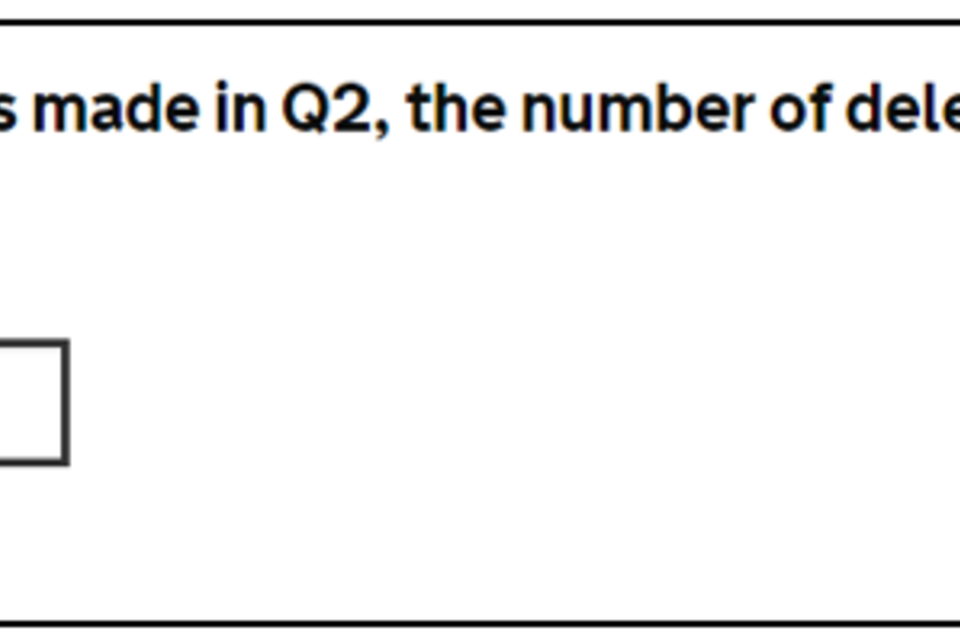
q3
This question asks you to record how many of the decisions reported in Question 2 were taken by planning officers under delegated powers and without referral to the planning committee. You should exclude those decisions referred for consideration by the committee even if the final decision was taken by an officer. This entry must not be greater than the number of decisions shown in CPS1 Question 2.
Any decisions made using enhanced delegation powers or emergency powers provided through the Local Government Act – e.g. in the light of Coronavirus - should be included.
Question 4
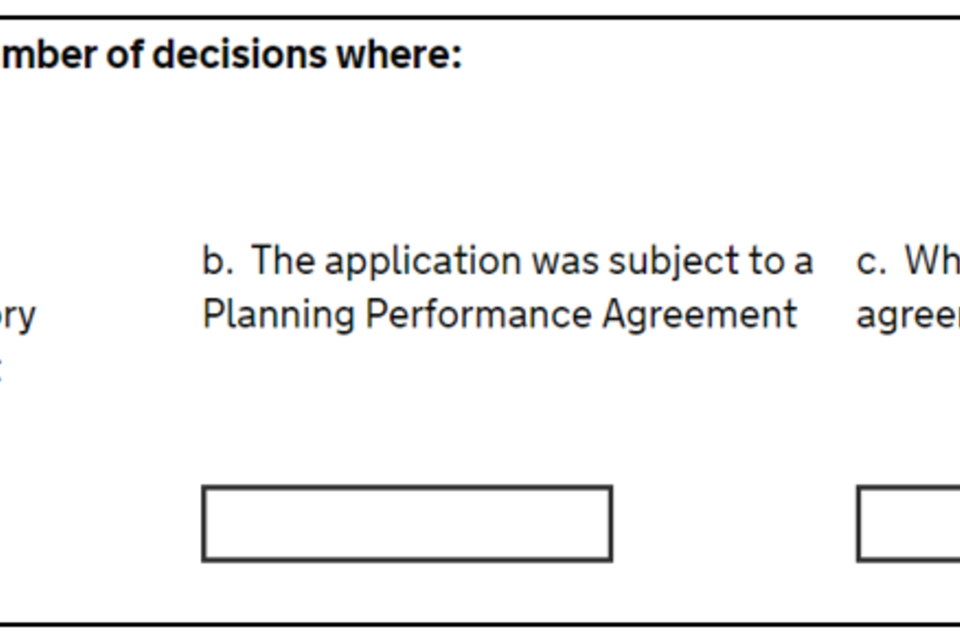
q4
Question 4a asks you to record the number of decisions where a statutory environmental statement was submitted to the local planning authority, as required under the Town and Country Planning (Environmental Impact Assessment) Regulations 2011 (SI 2011/1824).
Please also include environmental statements submitted by a developer in respect of a development which does not fall within either Schedule 1 or Schedule 2, but where the developer has agreed or opted to treat the planning application as if it did fall within the scope of the Environmental Impact Assessment Regulations.
Please exclude any environmental information or documentation submitted as a voluntary adjunct to a planning application and not treated as an environmental statement for the purposes of the Environmental Impact Assessment Regulations.
Question 4b asks you to record the number of decisions where the application was subject to a Planning Performance Agreement.
Question 4c records the number of decisions where the application was subject to a written agreed extension of time.
If a decision relates to a renegotiated Planning Performance Agreement, it should be reported at Question 4c, rather than at Question 4b, as a decision for which there was a written agreed extension of time.
The sum of the numbers reported at Questions 4a, 4b and 4c is not expected to equal the number of decisions made during the quarter as reported as Question 2 because it is assumed that many decisions will not have been subject to any type of extension of time.
The above guidance means that a single decision may need to be recorded at more than one of Question 4a, 4b and 4c, such as in the case where a statutory environmental statement has been submitted to the local planning authority for an application that was subject to a Planning Performance Agreement, which would be reported at both Question 4a and Question 4b.
Question 5
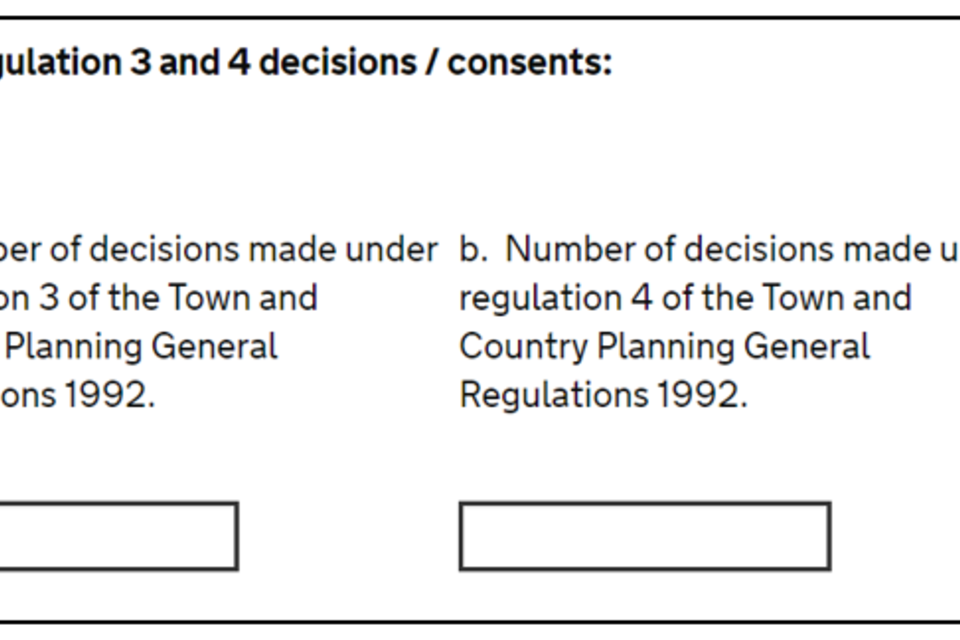
q5
Question 5 asks for information about the number of decisions made under Regulations 3 and 4 of the Town and Country Planning General Regulations 1992. Separate totals are requested for each Regulation. These regulations apply to cases relating to a local planning authority’s own land. In particular, Regulation 3 relates to developments it intends to carry out itself on its own land for the authority’s own purposes, whereas Regulation 4 relates to development for other purposes, such as for commercial activities when the authority doesn’t intend to develop the land itself.
County councils should enter:
-
Question 5a: the total number of planning permissions issued in the quarter under Regulation 3 of the Town and Country Planning General Regulations 1992 which relate to ‘county matters’ and other developments that would have been determined by the district council were they not Regulation 3 developments (for example applications for school developments).
-
Question 5b: the total number of planning permissions issued in the quarter under Regulation 4 of the Town and Country Planning General Regulations 1992 which relate to ‘county matters’.
Metropolitan districts, unitary authorities, London boroughs and National Park Authorities should enter:
-
Question 5a: the total number of planning permissions issued in the quarter under Regulation 3 of the Town and Country Planning General Regulations 1992, which relate to ‘county matters’.
-
Question 5b: this box should be left blank as it should only be completed by county councils.
Question 6: Number of decisions
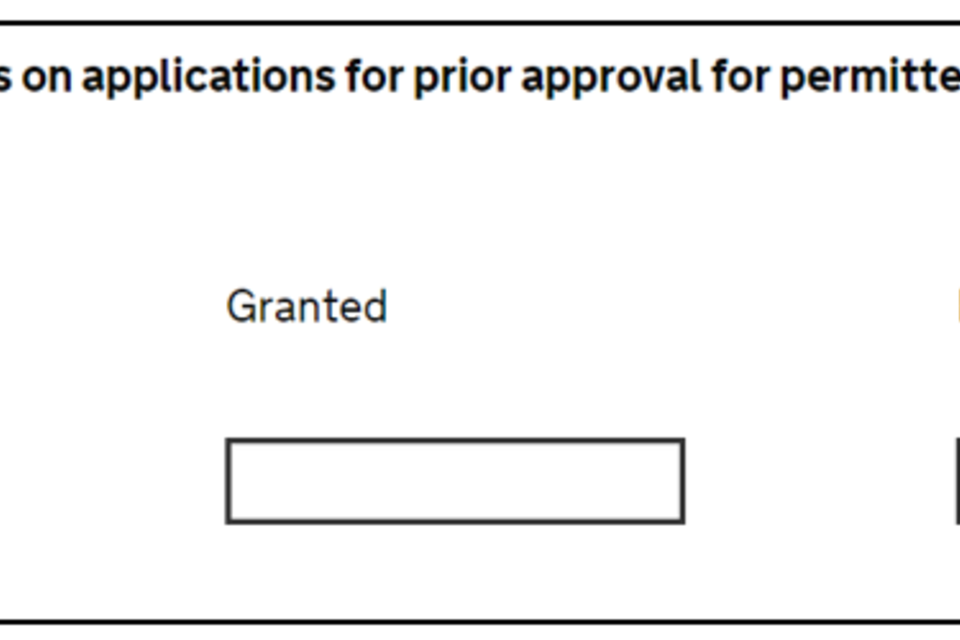
q6
Question 6 requests a breakdown of decisions on applications for prior approval for county matters only during the quarter in relation to permitted development rights under the Town and Country Planning (General Permitted Development) (England) Order 2015.
It asks for:
(i) the number of prior approval applications where prior approval is not required
(ii) the number granted; and
(iii) the number refused
In practice, applications where prior approval is not required include:
- Any applications where the local planning authority has provided written notice of their determination that prior approval is not required.
- Any applications granted implicitly, as a result of the local planning authority taking no action.
Granted applications include:
- Any applications where a local planning authority has made an explicit decision following an objection or following consideration of evidence provided.
- Any applications where the local planning authority has provided a written notice giving their prior approval.
Refused applications include:
- Any applications where the local planning authority consider that the development is not acceptable under the requirements of prior approval and has provided written notice that the prior approval is refused.
Question 7: County Matters

q7
Question 7a – Notifications
This question should be completed by county councils only.
Please record all decisions relating to notifications under Circular 14/90 (electricity generating stations and overhead lines).
For these notifications, the ‘date decision despatched’ is the date that the planning authority sent views/comments to the originating body.
Question 7b - Certificates of lawful development
Please record the number of decisions relating to applications for certificates of lawful development. This includes:
(i) existing uses and developments, and
(ii) proposed uses and developments
Question 7c – Certificates of appropriate alternative development
Please record the number of decisions relating to applications for certificates of appropriate alternative development.
Question 8: Number of determinations

q8
This asks for the total number of decision notices issued in the quarter on applications for the determination of new conditions under the provisions of the Environment Act 1995 for the review of mineral planning permissions (ROMPs) and the periodic review of mineral planning permissions. These should be excluded from the detailed data collected at CPS 2.
Question 9: Enforcement action
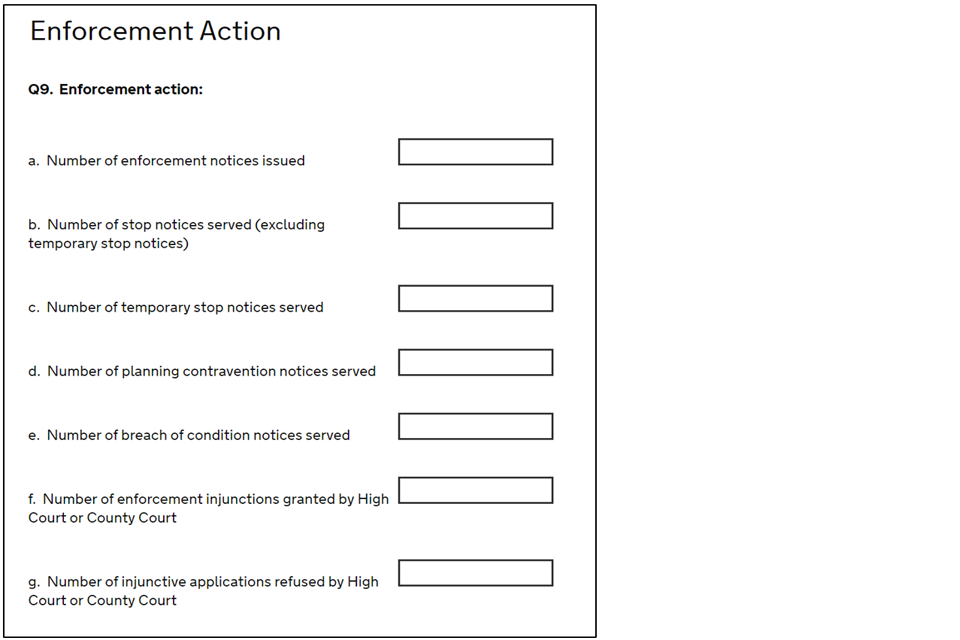
question 9
Question 9a asks for the number of enforcement notices issued (under section 172 of the Town and Country Planning Act 1990). Where two or more copies of the notice have been served on everyone with an interest in the land, only one notice should be recorded.
Question 9b asks for the number of stop notices served (under section 183 of the Town and Country Planning Act 1990), excluding temporary stop notices. These should be limited to each particular activity the authority seeks to prohibit. Where several identical notices, prohibiting the same activity on land, are served on a number of people, only one should be recorded.
Question 9c asks for the number of temporary stop notices served (under section 171E to section 171H of the Town and Country Planning Act 1990). These should be limited to each particular activity the authority seeks to prohibit. Where several identical notices, prohibiting the same activity on land, are served on a number of people, only one should be recorded.
Question 9d asks for the number of planning contravention notices served (under section 171C of the Town and Country Planning Act 1990). Where the same notice is served on several different people known, or thought, to have an interest in the same land, only one should be recorded. But, where the first notice is served again, later in the investigative process (e.g. because the first notice is ignored or not fully answered) the second or any subsequent notice should be recorded separately.
Question 9e asks for the number of breach of condition notices served (under section 187A of the Town and Country Planning Act 1990). The number recorded should be limited to one per breach.
Question 9f asks for the number of enforcement injunctions granted (under section 187B of the Town and Country Planning Act 1990). They do not relate to any injunction sought in the Court under section 222 of the Local Government Act 1972. Please include only injunctions granted by courts, not any which the authority may have sought under its own powers. For each breach only the first decision by the Court should be recorded. For a series of interlocutory injunctions to restrain the same breach of control, only the first should be recorded, even if the injunction is finally refused. If separate injunctions to restrain the same breach are simultaneously granted, only one injunction should be recorded.
Question 9g asks for the number of injunctive applications refused (under section 187B of the Town and Country Planning Act 1990). They do not relate to any injunction sought in the Court under section 222 of the Local Government Act 1972. Please include only injunctions refused by courts, not any which the authority may have sought under its own powers. For each breach only the first decision by the court should be recorded.
Figures are no longer needed on numbers of decisions on applications for the discharge of conditions under Article 27 of the Town and Country Planning (Development Management Procedure) (England) Order 2015 (as amended).
CPS2
CPS2: details of county matter planning decisions made during the quarter
The CPS2 form records more detail on the total number of decisions recorded in CPS1 Question 2. The information entered on the CPS2 form should relate only to ‘county matters’, as defined above. Please complete a single entry in CPS2 for every determination made during the quarter. The number of entries should equal the total number of decisions made as recorded in CPS1 Question 2.
The information gathered on this form is used, among other things, to calculate local authorities’ performance for the purposes of designating under-performing authorities under section 62A of the Town and Country Planning Act 1990.
The decisions to be included (and those to be excluded) are defined in the notes for CPS1 Questions 1 and 2.
On the CPS2 form, the application for a variation or removal of condition should be coded under the same code as the original application (i.e. if original application was for a minor development, the application for a removal of condition should also be classified as a minor development).
If you enter a value in CPS1 Question 2, then the CPS2 form will appear, with a large grid containing a number of questions. This grid has a header, labelling it as ‘Decision #1’. After completing the questions within this grid, if you have more decisions to report information on, you should click the ‘Add Another’ button below. This will create a new grid within which you should report information about the following decision, and so on until all decisions have been reported.
You should add and complete a separate grid for each decision made (the number answered in CPS1 Question 2).
Question A: Application reference number

question a
Enter the unique reference number used by the local planning authority to identify each application.
Question B: Type of scheme
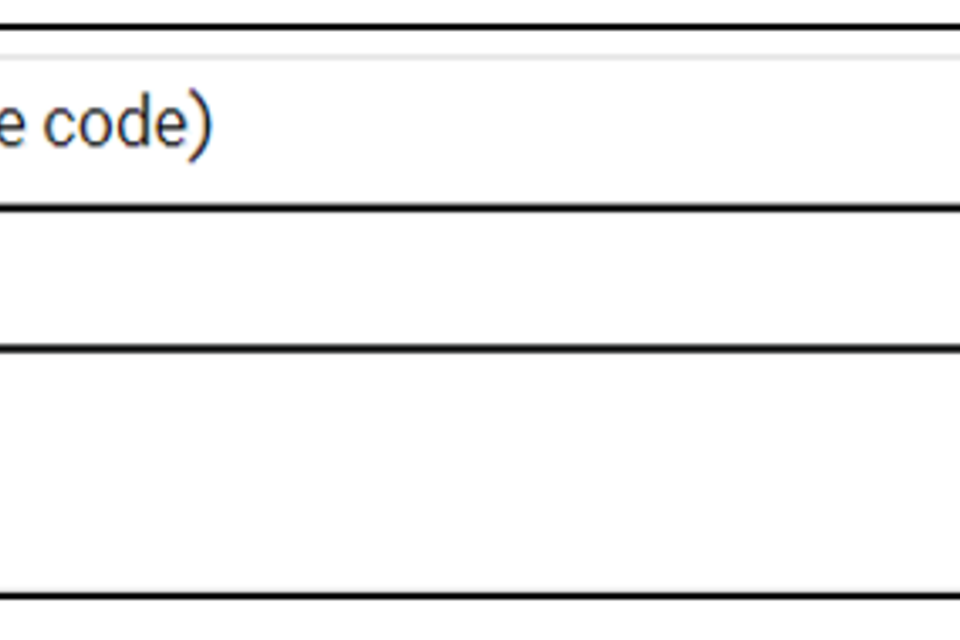
question b
Select a code from the drop-down menu to record the principal development on the site. Each code also contains its descriptor, and a list is also provided in the Annex, including further information for complex cases.
For example, an application for an office on a minerals extraction site should be recorded under the relevant minerals code. The same applies to applications for variation of conditions (under section 73 of the Town and Country Planning Act 1990) and for approval of reserved matters.
Question C: Nature of application

question c
Select a code from the drop-down menu to record the nature of the proposed development of the site. You may enter only one code for each development. Each code also contains its descriptor, and a list is also provided in the Annex.
If you enter ‘Other’ in Question C, you will also be asked to explain the nature of the application in a text box. This can help in improving the use of your data.
Question D: Granted or refused
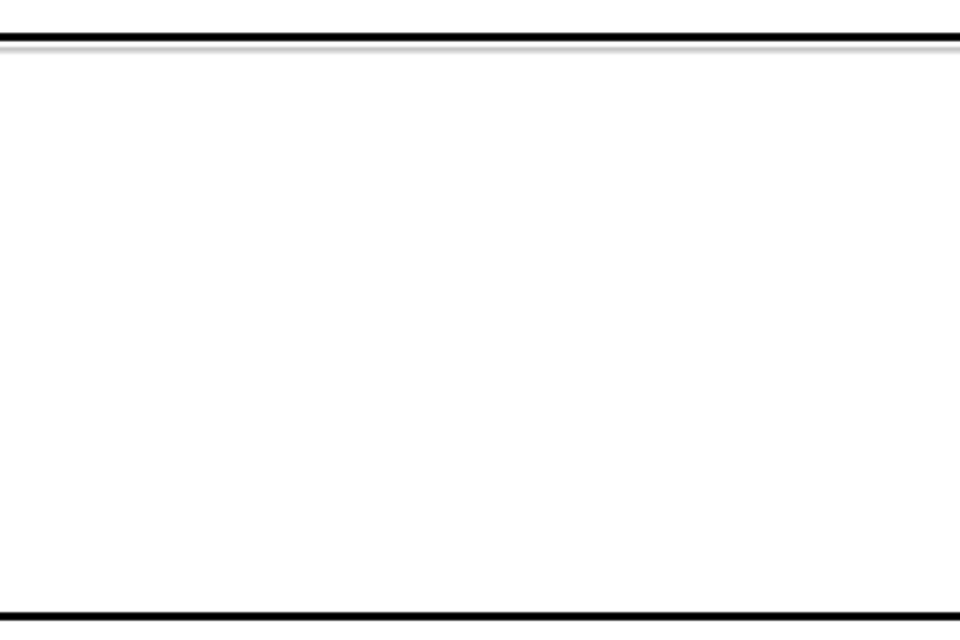
question d
Please identify whether the application was granted or refused.
Question E: Date valid application received
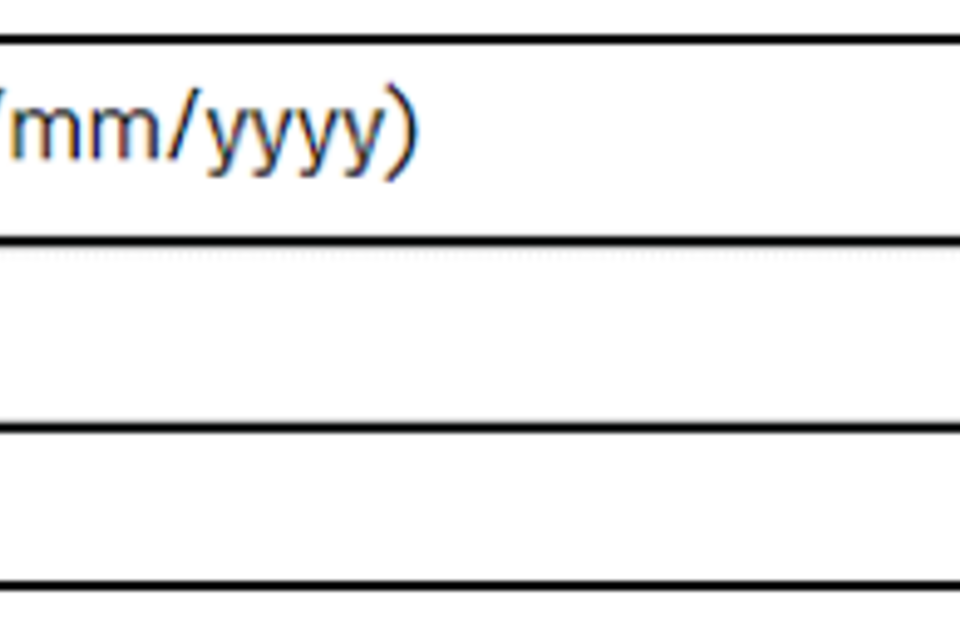
question e
Enter the date a valid application and the correct fee (where a fee is payable) were received by the planning authority.
Question F: Date decision dispatched
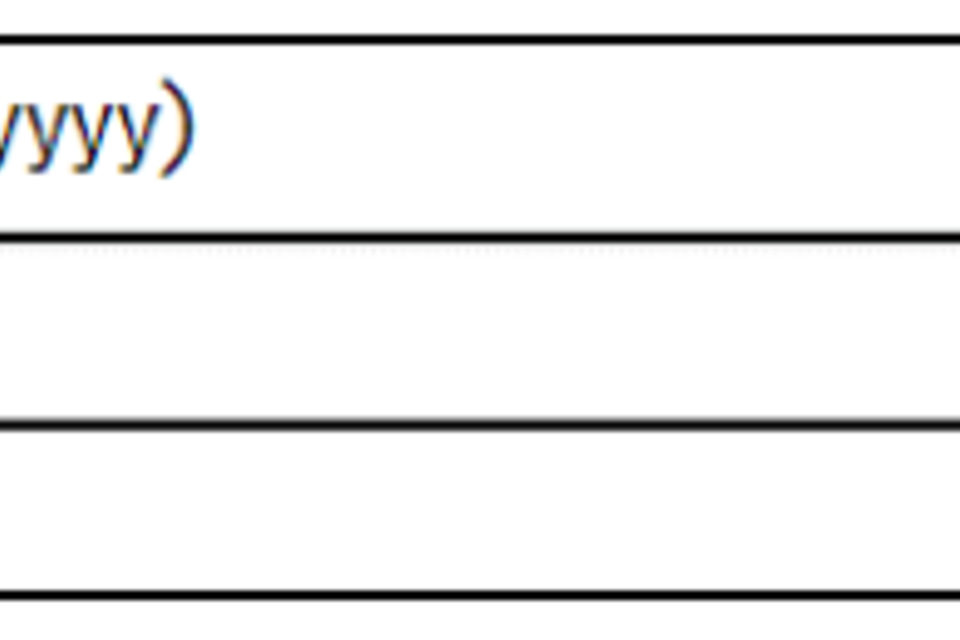
question f
Enter the date on which the notice of determination was dispatched to the applicant. This is the date on which the notice informing the applicant of the outcome of the application is sent out.
Question G: Planning Performance Agreement, extension of time or Environmental Impact Assessment
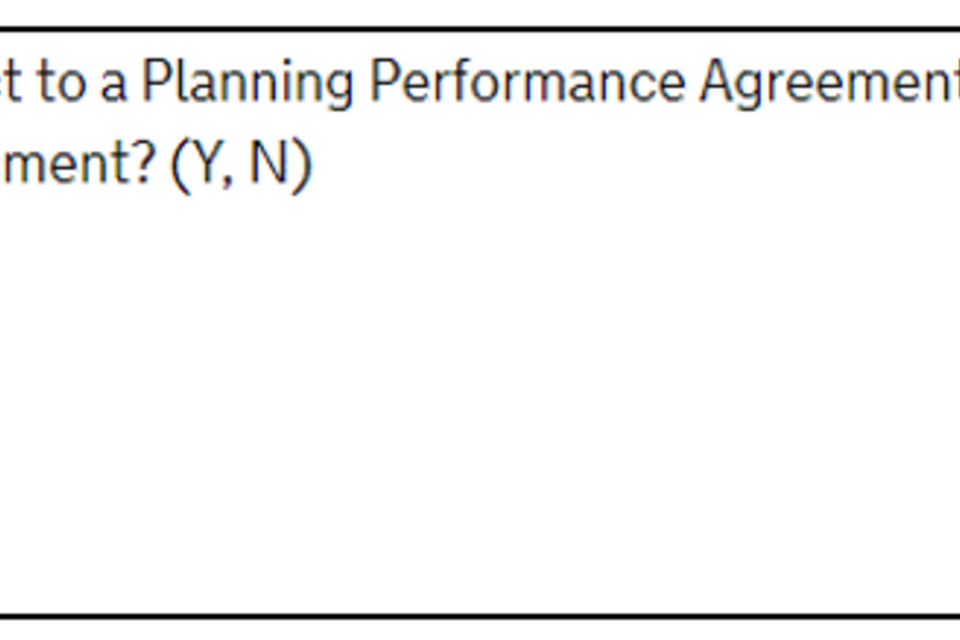
question g
Please identify whether the application was subject to a Planning Performance Agreement, and extension of time or an Environmental Impact Assessment.
These are defined as follows:
-
Planning Performance Agreement: a project management tool which sets timescales for actions between the local planning authority and an applicant which covers pre-application and application stages.
-
Extension of time: under article 34 of the Town and Country Planning (Development Management Procedure) (England) Order 2015 the local authority and applicant can agree to extend in writing the period for determining the application.
-
Environmental Impact Assessment: see the Town and Country Planning (Environmental Impact Assessment) Regulations 2011 (SI 2011/1824).
Question H: Where a Planning Performance Agreement, Extension of Time agreement or Environmental Impact Assessment applies, was the decision made within 16 weeks (EIA) or the agreed time limit?
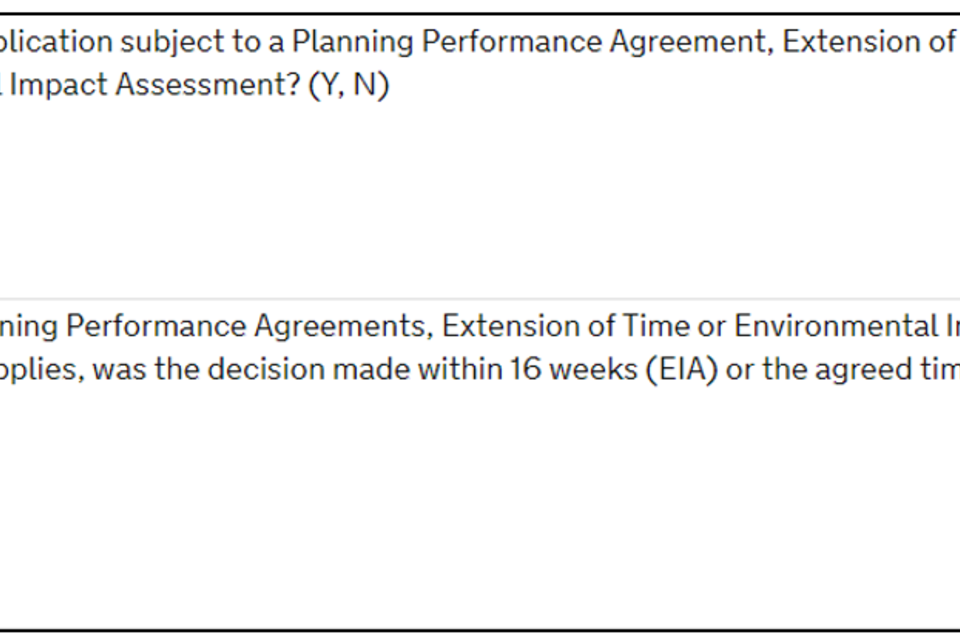
question h
If the decision was subject to either Planning Performance Agreement, Extension of Time or an Environmental Impact Assessment, please indicate whether the decision was made within either 16 weeks (for EIAs), or the agreed time limit.
Signing off the return
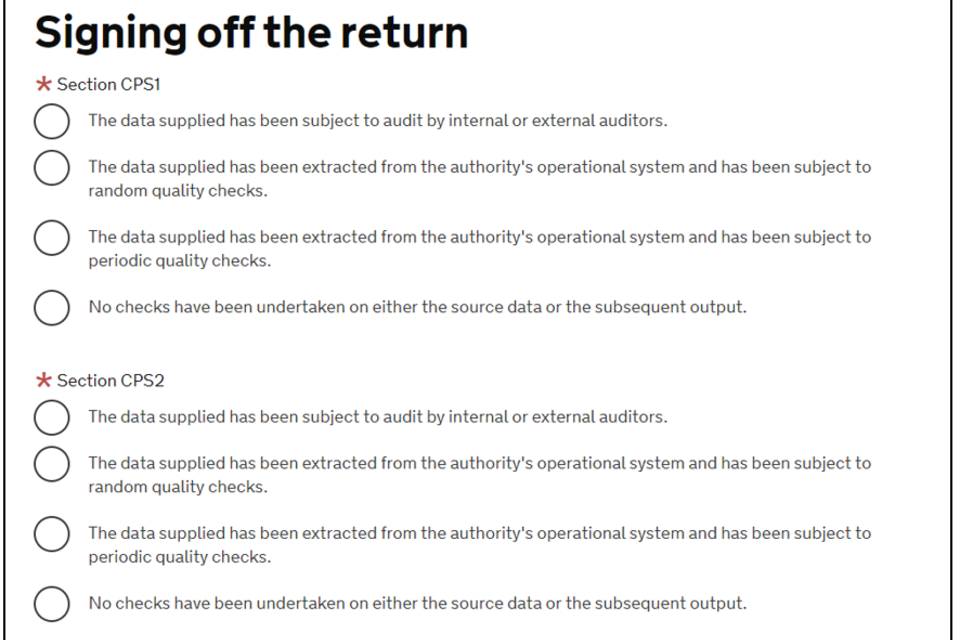
signing off return
The final Signing off the return sections asks users to verify the data being submitted and indicate the level of quality assurance undertaken. It is important to select the right box below so that you and the department are clear about the accuracy of the data submitted.
Viewing, saving and submitting

view save submit
The final part of the form offers 3 options – ‘PDF’, ‘Save’, ‘Submit’ – with each performing different functions.
Submitting data
Selecting Submit submits the finalised data to DELTA. Users should receive a confirmation email once submission is confirmed and a message will appear at the bottom of the screen, as below. If the submission contains any entry errors, these will be flagged, and users will need to address each before submission can be confirmed. Please be aware that it may take several seconds for submission to be confirmed.

saved
Once submission has been confirmed, users are taken to their Data Store, where they can view all the data submitted. To submit data for a different site, users will need to navigate back to the Collection Requests by clicking on the navigation bar at the top of the page, as above, and selecting the same form again to enter more data.
Viewing and saving
Selecting PDF takes users to a separate window within their web browser which allows them to view their entry and print or save it to their desktop.
Selecting Save allows users to save their entry in the personal Data Store. This can be reviewed and submitted at a later date. To access the Data Store, users will need to either select ‘Submissions’ and then ‘Data Store’ after logging in, or they can access from the navigation bar at the top of the page.

delta
Reminder
Users must Submit their forms once completed, for data to be sent to the DLUHC. Clicking Save will maintain the data for users to complete entry at a later point.
Glossary
The Plain English guide to the planning system explains how the planning system in England works. In particular, the flow chart in Annex C on page 20 shows the stages in the planning application process. Information on the definitions most relevant to the forms are given below, in alphabetical order.
Applications received
The following applications are included:
(a) Valid applications for planning permission for development under Articles 5,6 and 7 of the Town and Country Planning (Development Management Procedure) (England) Order 2015, (SI 2015/595) (as amended) namely:
(i) Applications for outline planning permission
(ii) Applications for approval of reserved matters
(iii) Applications for full planning permission
This includes any application for time limited permission and any application that is accompanied by an environmental statement.
(b) Applications under section 73 of the Town and Country Planning Act 1990 to vary or remove conditions (including applications for minor material amendments).
(c) Developments which would normally have been permitted under the Town and Country Planning (General Permitted Development) Order 1995 but have come before the local planning authority for determination because they require an Environmental Impact Assessment.
(d) Valid applications for listed building consent under section 8 of the Planning (Listed Buildings and Conservation Areas) Act 1990.
(e) Valid applications for planning permission for relevant demolition of an unlisted building in a conservation area under section 70 of the Town and Country Planning Act 1990.
(f) Valid applications for consent to display advertisements under the Town and Country Planning (Control of Advertisements) (England) Regulations 2007 (SI 2007/783) (as amended).
(g) Valid applications under regulations 3 and 4 of the Town and Country Planning General Regulations 1992 (SI 1992/1492) (as amended).
Enforcement activity
Local planning authorities have discretionary powers to take formal enforcement action if, in their view, an unacceptable breach of planning control has occurred. Where it is necessary to stop a breach immediately, the authority may issue a Temporary Stop Notice. This will halt development for 28 days while the alleged breach is investigated and further enforcement action is considered, without the need for the authority to issue an associated enforcement notice.
The authority may issue an Enforcement Notice requiring the alleged breach to be remedied. If an authority considers that any activity alleged in an Enforcement Notice should cease before the end of the specified compliance period, they may serve a Stop Notice prohibiting continuation of that activity. Where conditional planning permission has been granted for a development of land and there has been a failure to comply with one or more of the conditions, an authority may serve a Breach of Condition Notice on any person who is carrying out or has carried out development, or anyone having control of the land, requiring compliance with the conditions specified in the notice.
Permitted development rights
Planning permission for some types of development has been granted nationally through the Town and Country Planning (General Permitted Development) (England) Order 2015. In some cases, if the legislation is complied with, developments can go ahead without the requirement to notify the local planning authority and hence no way of capturing data exists. In other cases, the General Permitted Development Order requires an application to the local planning authority to determine whether prior approval is required.
Prior approvals for permitted developments
Prior approval means that a developer has to seek approval from the local planning authority that specified elements of the development are acceptable before work can proceed. The matters for prior approval vary depending on the type of development and these are set out in full in the relevant parts in Schedule 2 to the General Permitted Development Order. A local planning authority cannot consider any other matters when determining a prior approval application.
Appendix
Definition of ‘County matters’
Applications for developments which are termed ‘county matters’ are, broadly, those which relate to minerals and waste and associated developments. A more detailed definition is contained in:
a. Paragraph 1 of Schedule 1 to the Town and Country Planning Act 1990
b. The Town and Country Planning (Prescription of County Matters) (England) Regulations 2003 (SI 2003 /1033).
Definition of ‘major development’
For the purpose of data collection for the CPS1/2 form, all applications for county matter development are treated as major development. Major development is defined in article 2 of the Town and Country Planning (Development Management Procedure) (England) Order 2015 (SI 2015/595). Some county matter development may be capable of being minor development under this definition for the purpose of calculating the statutory time period for decisions. In those situations authorities should determine the application within the appropriate statutory timescale but still record the application as a major development on the CPS1/2 form and it will be counted as being “in time” in the statistics if it is determined within 13 weeks (or within a longer time period where agreed in writing with the applicant).
CPS2 Question B
| Mineral | Code |
|---|---|
| Chalk | 1 |
| China and ball clay | 2 |
| Clay/shale | 3 |
| Coal (deep-mined) | 4 |
| Coal (open-cast) | 5 |
| Gypsum/anhydrite | 6 |
| Igneous rock | 7 |
| Ironstone | 8 |
| Limestone/dolomite | 9 |
| Oil/gas (exploration) | 10 |
| Oil/gas (appraisal) | 11 |
| Oil/gas (development) | 12 |
| Sand and gravel | 13 |
| Sand (excluding silica sand) | 14 |
| Sandstone | 15 |
| Slate | 16 |
| Vein minerals | 17 |
| Other minerals | 18 |
| Recycling plants for secondary aggregates | 19 |
| Coal-bed methane production | 20 |
| Coal-bed methane exploration/appraisal | 21 |
| Silica sand | 22 |
| Waste | Code |
|---|---|
| Landfill | 30 |
| Transfer station | 31 |
| Treatment | 32 |
| Storage | 33 |
| Oil/solvent recovery | 34 |
| Incineration with energy recovery | 35 |
| Incineration without energy recovery | 36 |
| Scrap yards | 37 |
| Civic amenity | 38 |
| Materials recovery/recycling (other than aggregates) | 39 |
| Other waste | 40 |
| Composting | 41 |
| Anaerobic digestion | 42 |
| Pyrolysis | 43 |
Other county matters 50
In the case of applications relating to oil or gas, one of the three codes 10, 11 or 12 should be used according to what stage of development is proposed.
- Use Code 10 for exploration activities which require planning permission, such as the drilling of test bore-holes. Exclude any exploration work, which is permitted by the Town and Country Planning (General Permitted Development) Order 2015, such as seismic tests.
- Use Code 11, the ‘appraisal’ category, for operations carried out after the discovery of oil or gas but before commercial extraction begins. This would include work to establish the extent of the oil/gas operations.
- Use Code 12, the ‘development’ category, for commercial extraction and related activities.
Code 50: ‘Other county matters’ should be used very infrequently, because most ‘county matters’ developments should be classified as either minerals or waste developments. Examples of ‘other county matters’ are:
(a) railway depots and wharves located away from mineral extraction sites
(b) landfill gas control/utilisation schemes
Developments on minerals and waste sites which are connected with the main development should not be classified as ‘other county matters’ but should be given an appropriate minerals or waste code.
Examples of such developments are:
(a) workshops, office buildings and storage areas on landfill sites
(b) access to minerals and waste sites
(c) ancillary works on minerals and waste sites
(d) vehicle parking on existing minerals and waste sites
Applications for a variation to a condition or conditions which relate to minerals (for example) should be given an appropriate minerals code.
CPS2 Question C
| Nature of application | Code |
|---|---|
| New mineral-working, exploration or appraisal/waste disposal site | 1 |
| Extension to area of existing site* | 2 |
| Extension to life of existing site | 3 |
| Deepening of working or other changes within existing site | 4 |
| Increasing void space for landfill* | 5 |
| On-site manufacturing or ancillary operations/uses** | 6 |
| Variation of condition(s) | 7 |
| Other (i.e. not in 1-7 above) | 0 |
*For landfill developments, Code 2 relates to lateral extension and Code 5 to vertical extension of void space.
**An example of an ancillary use would be the storage of skips on a waste site.
